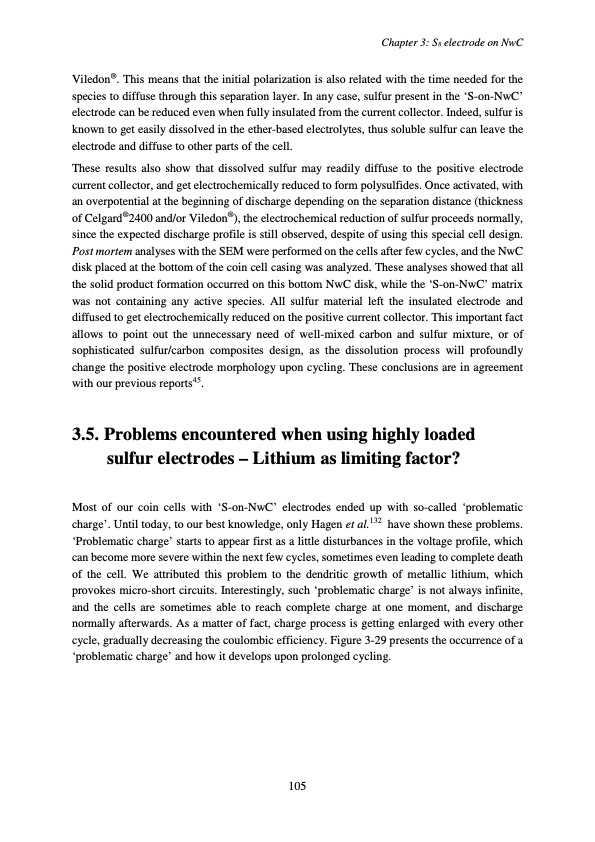
PDF Publication Title:
Text from PDF Page: 109
Viledon®. This means that the initial polarization is also related with the time needed for the species to diffuse through this separation layer. In any case, sulfur present in the ‘S-on-NwC’ electrode can be reduced even when fully insulated from the current collector. Indeed, sulfur is known to get easily dissolved in the ether-based electrolytes, thus soluble sulfur can leave the electrode and diffuse to other parts of the cell. These results also show that dissolved sulfur may readily diffuse to the positive electrode current collector, and get electrochemically reduced to form polysulfides. Once activated, with an overpotential at the beginning of discharge depending on the separation distance (thickness of Celgard®2400 and/or Viledon®), the electrochemical reduction of sulfur proceeds normally, since the expected discharge profile is still observed, despite of using this special cell design. Post mortem analyses with the SEM were performed on the cells after few cycles, and the NwC disk placed at the bottom of the coin cell casing was analyzed. These analyses showed that all the solid product formation occurred on this bottom NwC disk, while the ‘S-on-NwC’ matrix was not containing any active species. All sulfur material left the insulated electrode and diffused to get electrochemically reduced on the positive current collector. This important fact allows to point out the unnecessary need of well-mixed carbon and sulfur mixture, or of sophisticated sulfur/carbon composites design, as the dissolution process will profoundly change the positive electrode morphology upon cycling. These conclusions are in agreement with our previous reports45. 3.5. Problems encountered when using highly loaded sulfur electrodes – Lithium as limiting factor? Most of our coin cells with ‘S-on-NwC’ electrodes ended up with so-called ‘problematic charge’. Until today, to our best knowledge, only Hagen et al.132 have shown these problems. ‘Problematic charge’ starts to appear first as a little disturbances in the voltage profile, which can become more severe within the next few cycles, sometimes even leading to complete death of the cell. We attributed this problem to the dendritic growth of metallic lithium, which provokes micro-short circuits. Interestingly, such ‘problematic charge’ is not always infinite, and the cells are sometimes able to reach complete charge at one moment, and discharge normally afterwards. As a matter of fact, charge process is getting enlarged with every other cycle, gradually decreasing the coulombic efficiency. Figure 3-29 presents the occurrence of a ‘problematic charge’ and how it develops upon prolonged cycling. 105 Chapter 3: S8 electrode on NwCPDF Image | Accumulateur Lithium Soufre

PDF Search Title:
Accumulateur Lithium SoufreOriginal File Name Searched:
WALUS_2015_archivage.pdfDIY PDF Search: Google It | Yahoo | Bing
Sulfur Deposition on Carbon Nanofibers using Supercritical CO2 Sulfur Deposition on Carbon Nanofibers using Supercritical CO2. Gamma sulfur also known as mother of pearl sulfur and nacreous sulfur... More Info
CO2 Organic Rankine Cycle Experimenter Platform The supercritical CO2 phase change system is both a heat pump and organic rankine cycle which can be used for those purposes and as a supercritical extractor for advanced subcritical and supercritical extraction technology. Uses include producing nanoparticles, precious metal CO2 extraction, lithium battery recycling, and other applications... More Info
| CONTACT TEL: 608-238-6001 Email: greg@infinityturbine.com | RSS | AMP |